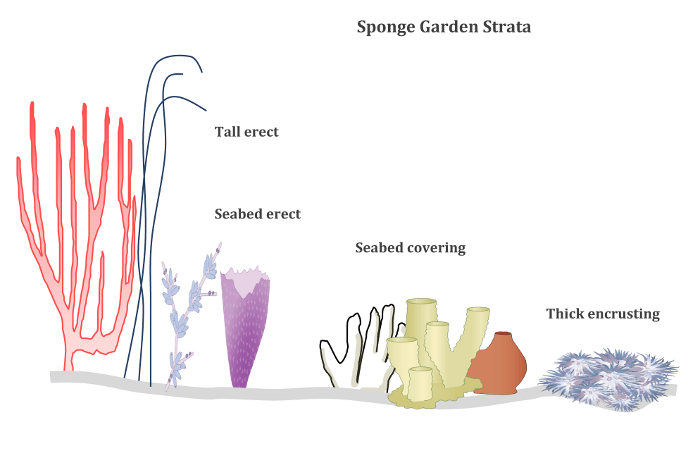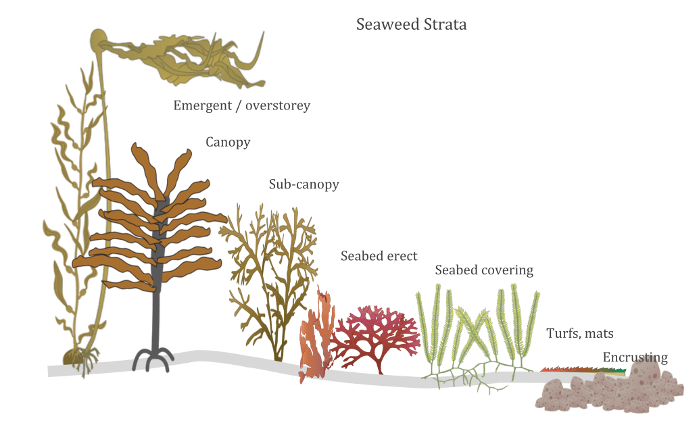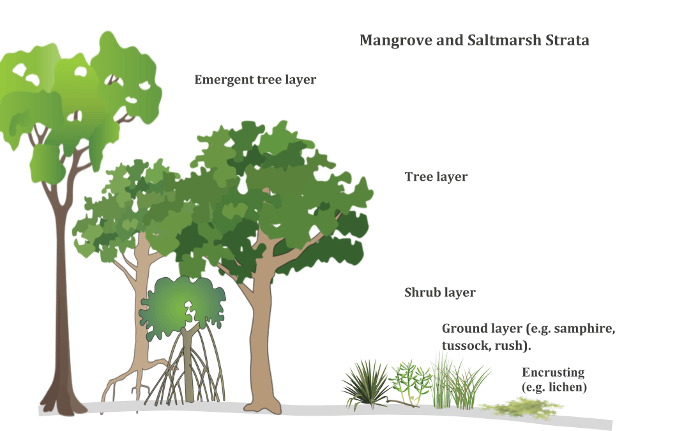The mapping and monitoring of marine biotopes relies heavily on the use of visual observation and imaging techniques. The morphospecies component provides a scheme for the systematic classification of species and biological groups based on visual characteristics, such as from robotics or towed video. This component supports obtaining biodiversity data from underwater imagery using a standardised system and can be applied in all marine habitats. This is particularly important where the species do not have taxonomic descriptions or cannot be identified without collecting specimens.
Classifying biota in imagery typically involves scoring morphospecies that are defined with a range of visually identifiable characteristics such as general growth form, surface structures, surface texture and colour. The utility of morphospecies is related to the relationship between environmental conditions (e.g. substrate, current and exposure) and the biological forms present that allows sessile benthic communities in particular to be classified to useful levels.
The biotope is the key level of biotic classification and management in CBiCS and the description of many biotopes relies heavily on visual morphological characteristics to near-species level, i.e. morphospecies.
Because of the large volumes of seabed imagery being collected by underwater robotics, there is considerable work in progress to develop automated, machine learning and classification. This automated classification is reliant on a standardised classification system and on adequadetly classified training data. There is therefore strong impetus for a standardised, universal morphospecies classification system that can be applied in most situations.

Key Objectives
The morphospecies component was designed to meet the following objectives:
- Standardised structure with universal application, from salt marshes to sponge gardens, incorporating existing schema where appropriate.
- The scheme resolves to near-species level to provide surrogacy for biodiversity.
- The scheme encompasses health and growth states, such as observations of diseased or damaged individuals and different structural forms of a species, such as sub-canopy, canopy and overstorey formations by Macrocystis kelp.
- Primarily based on visually-determined features but extensible to 3D structure properties (i.e. not reliant on inferred taxonomy).
- Strictly hierarchical in structure with nesting of subordinate morphological features (for the following advantages).
- Hierarchical levels and classes structured in accordance with the biotic component.
- Hierarchical levels and classes reflect implicit ecosystem features and functional properties.
- Hierarchy suits levels of image acuity, e.g. sensor type, quality, lighting and resolution.
- Hierarchy suits levels of observer capability, experience and expertise, ranging from citizen scientists, novice scientists to expert biologists.
- The system facilitates machine learning and automated image processing.
Other Classification Systems
A range of coarse-level morphospecies classification schemes exist, however most are restricted to specific sets of biota or habitat types. The most established classification schemes are for hard corals (e.g. Australian Institute of Marine Science and the National Oceanic and Atmospheric Administration coral reef classification systems) and sponges (e.g. Boury-Esnault and Rutzler 1997; Bell and Barnes 2001; Hooper 2003).
Attempts at morphospecies classification has typically involved the production of illustrated catalogues (e.g. Burton and Lundsten 2008, Tracey et al. 2014, Du Preez et al. 2015) that can lead users to an end node classification. However, these are non-hierarchical and non-universal. In Australia, the CATAMI morphological classification scheme (Althaus et al. 2015) represented an attempt at a national standard for hierarchical morphological classification. The CATAMI scheme was reviewed closely and not adopted for the CBiCS morphospecies component for the following key reasons:
- It includes taxonomic (Phylum) distinctions at the highest level, excludes many visual forms from entering the classification scheme – for example branching sponges and gorgonians, bushy bryozoans and hydroids, cushion sponges and ascidians.
- The scheme does not have a strict hierarchy – nested levels are not necessarily subordinate in their features.
- It excludes commonly encountered life forms, e.g. hydroid forms.
- It does not follow established schema for sponges.
- It does not resolve to near-species level and is therefore an impediment to biotope and finer assemblage descriptions.
- It is not suited for machine learning and automated image processing because of the lack of pseudo-hierarchy and taxonomic distinctions.
CBiCS Morphospecies Hierarchy
The CBiCs morphospecies classification hierarchy follows terrestrial vegetation approaches, particularly the classification of vegetation strata and vegetation life forms. There are six hierarchical levels, ranging from large, coarse features at the upper levels to finer features at the lower levels.
1 – Biotic layer or stratum (e.g. tall erect)
2 – General growth form (e.g. ascendant branching)
3 – Specific growth form (e.g. sparse candelabral branching)
4 – Sub-structure and surface features (e.g. flattened branches)
5 – Fine features, pattern and colouring
6 – Fine features, species level distinctions, growth and health states
The CBiCS morphospecies hierarchy can be explored by clicking here.
Level 1 – Biotic Layer
Level 1 biotic structural layers within the coastal and littoral zones are:
- Tree layer – canopy layer formed by vegetation with the growth forms of trees, mallee trees and palms.
- Shrub layer – middle or low canopy layer formed by shrubs, palms, grass trees and the like.
- Ground layer – plants with vertical structures but limited in height and without forming a canopy layer above the substratum.
- Encrusting layer – forms with little to no vertical structure, such as lichens, in the littoral and supralittoral zones in particular.
Level 1 biotic structural layers within sublittoral marine habitats include:
- Overstorey – vegetation, predominantly seaweeds, extending into a substantial portion of the water column and potentially to the surface..
- Canopy – Vegetation forming a layer at some height above the seabed, typically with open areas between the stipes and holdfasts beneath the canopy.
- Sub-canopy – vegetation forming a partial or full canopy at or close to the seabed, substantial crowding of stipes and branches beneath the canopy.
- Seabed erect – Erect plants and animals, living close to the seabed with growth predominantly into the vertical plane, often with a distinct attachment point such as a holdfast.
- Seabed erect – Erect plants and animals, living close to the seabed with growth predominantly into the vertical plane, often with a distinct attachment point such as a holdfast.
- Sub-erect small – small sessile biota, < 10 cm, occurring in small clumps or patches that have one or multiple attachment points and erect, semi-erect, rhizomatous, tufting or prostrate growth habit.
- Turf – dense to tightly compacted thalli forming a low covering of the substratum with a homogenous appearance.
- Encrusting – thin sheet-like structures following the contours of seabed. May have minor surface textural structures but no significant vertical mass.
- Mat – multi-layered and/or inter-woven biota forming a cohesive layer. Includes microbial mats and drift algal mats.
- Felt – microalgal or bacterial-derived fine layer of floc and gel with felt or velvety texture.
- Film / stain – thin film or layer, sometimes pigmented, with smooth texture and translucent to transparent.
- Buried – present within sediments with indicative features apparent at the surface, such as fistula, papillae or tentacles.
- Benthic free living – individual animals that are free living or as individually recognisable non-colonial sessile animals on the seabed.
- Water column – free living biota in the water column, including plankton and nekton.
- Sea surface – Free living or drifting biota at or on the sea surface.





Levels 2 & 3 – Growth Forms
The growth form classes for coastal and littoral biota follows standard botanical classes, such as tree, shrub, sub-shrub, fern, tussock grass, forb, etc. Secondary growth form characteristics include aspects such as branching habit, for example prostrate, decumbent and erect branching of ground layer vegetation.
For sublittoral classes, some growth forms are confined to particular taxa, for example seagrass, Caulerpa seaweed, erect coralline algae, aggregated ascidians, polyp sheets and hard coral growth forms. There are also growth form represented across different phyla, such as cushion fauna (sponges and colonial ascidians), mesh fans (hydroids, gorgonians and sponges) and branching colonies (gorgonians and sponges).
Large brown seaweeds are divided into growth forms according to the nature of fronds, stipes and stems. Seabed erect thallose seaweeds are an exception in that they are first divided into colour groups, i.e. red, green and brown thallose algae, as these have implicit ecological values and align well with biotope distinctions. The growth forms within thallose seaweeds include flat branching, filiform branching, filamentous, sheet-like, foliose and saccate forms.
Sessile invertebrates have diverse growth forms. Seabed erect examples include branching, globose, flabellate, palmate, tubular, cup-like and whip-like forms.
Finer Level Features
Finer features used for morphospecies identification include finer-level branching characteristics, leaf or frond characteristics such as shape and edge features, surface sculpturing and texturing and colour, hue and patterning.
Scheme Improvements
The CBiCS morphospecies component was developed and tested using known species and their morphological variants to assist in assigning defining visual features at the appropriate hierarchical level. There is presently ongoing testing of the scheme through existing ground-truthing and monitoring surveys to ensure the scheme is ecologically meaningful, practical and in accordance with the other CBiCS components. Minor adjustments to the scheme are expected to occur over the coming months.
The morphospecies component hierarchy can be explored by clicking here.
